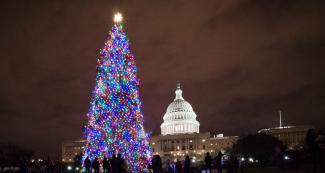Christmas Day

Photo by Lance Cheung, USDA via Flickr / PDM 1.0
Origins of Christmas Day
The custom of celebrating Christmas dates back to the year 336 A.D. It has its roots in ancient times and is celebrated around the world. Christmas is the celebration of the birth of Jesus Christ, who Christians acknowledge as the son of God and the savior of the world.
In the United States of America, Christmas was established as a federal holiday when President Ulysses S. Grant signed a bill on June 26, 1870.
Cultural Significance
According to congressional records, the 1870 law was promoted by area “bankers and businessmen” who wanted certain holidays to be formalized. Some historians argue that the bill was not derailed by arguments about separation of church and state because businessmen recognized the economic potential. Customs such as writing Christmas cards, decorating Christmas trees, telling stories about Santa Claus and giving gifts were more about financial benefits than any religious belief. Such customs helped create a sense of community and unity in the wake of the Civil War and the industrial revolution.
Nearly all U.S. Christians (96%) say they celebrate Christmas. A new Pew Research Center survey also finds that 81% of non-Christians in the United States celebrate Christmas, testifying to the holiday’s wide acceptance – or, at least, its unavoidability – in American society.
Implications for Ending Racism
When we examine our Christmas traditions with a racially sensitive lens, our theological, psychological and sociological perspectives are challenged. For those who celebrate Christmas as a Christian observance, the scriptures offer insight. God loves everybody and everybody wants to feel seen and valued. For those who are not, the Golden Rule still applies, do unto others as you would have them do unto you.
For the Christmas season and beyond, one of the best practices to help end racism is to learn to identify it and then take steps to stop it. Ask questions. Use an anti-racism lens to facilitate the recognition of the systems that are impacted. What do you see when you look at a manger? What is so controversial about Black Santas that human lives are threatened?
